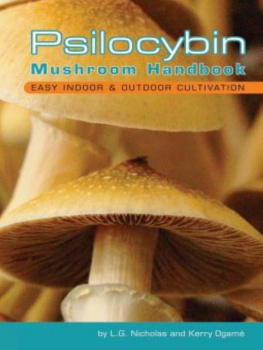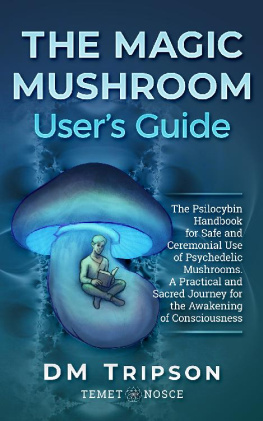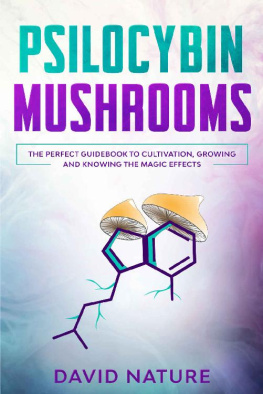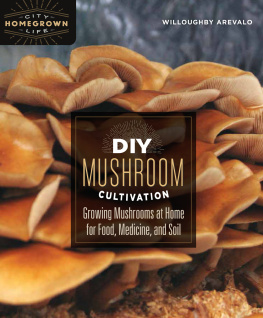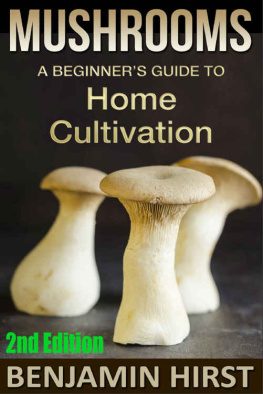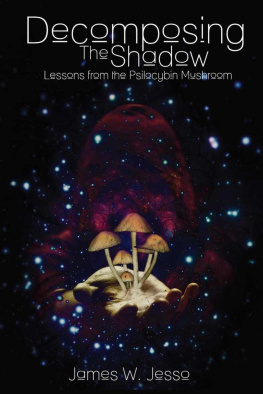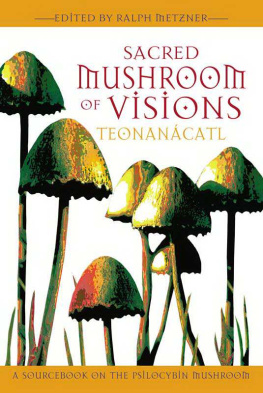This book is dedicated to the many mycologists who helped to uncover the secrets behind the life cycle of these little mushrooms, and to the Mazatec peoples of Mexico, who have for centuries protected, nourished, and handed down the ceremony, knowledge, and wisdom they reveal.
We would also like to thank Kat for having so generously agreed to produce a new Psilocybe cubensis life cycle illustration. Her beautiful artwork illuminated the pages of the book that germinated our mycological careers, and it is a great honor to have some of that same light grace our own little book.
Finally, we would like to thank Mellea R. Millaria, our little honey mushroom, for her keen photographic eye, patience, and beauty. Without her unwavering support, this book would surely never have fruited.
PROLOGUE
In 1992, while perusing the dusty aisles of a Manhattan antiquarian book-shop, we happened upon a dog-eared copy of O.T. Oss and O.N. Oerics Psilocybin: Magic Mushroom Growers Guide . This slim volume, with its densely packed text and fanciful, otherworldly line drawings, held for us an immediate and irresistible allure. Like an illuminated manuscript or a book of spells, it glimmered and hummed with meaning, reaching out to us from the crowded shelves. It seemed less a book than a communiqu, a missive cast out into the world, waiting silently for years to at last make its way into our hands. We already held a considerable affection for the mushrooms in question, but we had never before contemplated growing our own.Yet by the time we exited the shop, book in hand, the idea seemed self-evident, organic: Of course , we thought, we will grow our own mushrooms!
For us, this book has never lost its intense personal appeal, but we were hardly the sole intended recipients of the secrets it contained. First published in 1976, Psilocybin has been in print ever since and has sold over 150,000 copies. The methods it espouses have inspired the careers of untold numbers of mushroom cultivators and kitchen mycologists (your humble authors among them), and sparked a flurry of underground experimentation and innovation. Although several books and pamphlets on the subject of psilocybin mushroom cultivation have been published before and since Psilocybin: Magic Mushroom Growers Guide, this book is unique in a number of important ways.
First of all, it presents a series of methods that can be performed by nearly anyone, requiring only a limited investment in specialized tools and materials, such as a pressure cooker and Petri dishes. Second, unlike previously available techniques, Oss and Oerics methodology is relatively simple, reliable, and quite productive. Though they did not invent any of the methods they espoused, they were the first to combine them into such an efficient and effective system. Finally, it is far more than a simple manual for the cultivation of psilocybin mushrooms. With its philosophical asides, lovely, phantasmagorical illustrations, and Lovecraftian speculations about the off-world origins of the organisms and their import for humankind (including a statement of purpose supposedly dictated to one of the authors by the mushroom overlords themselves!), it is, above all, a great read.
Although Psilocybin: Magic Mushroom Growers Guide is a classic, a new manual on psilocybin mushroom cultivation is nonetheless needed. While Psilocybin has stood the test of time as literature, it has become obsolete as a growers guide. As easy and reliable as the Oss & Oeric method was, it still left a great deal of room for improvement. In the 30 years since Psilocybin first appeared, many cultivation techniques have been considerably refined or supplanted entirely, and a number of new technological and mycological discoveries have been made.
The purpose of this book is to update and complement the methods Oss and Oeric described. It is our hope that by creating a new resource for beginning Psilocybe mushroom cultivators, the burden of being such a resource will be lifted from that book. Psilocbyin Mushroom Handbook updates the outmoded technical information within its predecessors pages, leaving Psilocybin: Magic Mushroom Growers Guide free to be seen for what it is: a work of art. It is our humble wish that our efforts here will provide concise and well organized instructions for mushroom cultivation that incorporate the most up-to-date practices. In so doing, we hope to help keep in print the book that first sparked our mushroom imagination to life so it will continue to inspire new students of psycho-mycology for years to come.
INTRODUCTION
If you spend a little time perusing the published literature or the various Web sites on the subject of Psilocybe mushroom cultivation, you will quickly notice the dizzying array of methods that one can use to grow these mushrooms.This is particularly true for Psilocybe cubensis : there are the Psilocybe Fanaticus Technique, methods utilizing wild bird seed, composted cow or horse manure, worm castings, and so on. As you will come to see, this is a very robust species with which to work, easily adaptable to a wide variety of substrates and conditions. As a result, it is the ultimate tinkerers mushroom, and has inspired countless experiments in search of the best, newest, or simply the wackiest method to make it fruit.
Such primary research stands as one of the paramount joys of working in science, but it can also be its greatest frustration, particularly for a beginner. Some 99.99% of scientific investigations result in setbacks, dead ends, or outright failure, and that is exactly how it should be. Only by process of elimination does one arrive at that elusive, precious 0.01% Holy Grail of success (proving, in the end, that failures arent really failures anyway). Anyone who has spent any amount of time doing scientific research eventually becomes comfortable with this seemingly skewed ratio. One comes to see failures as simply part of the process, even sometimes a welcome part, since there is usually much to be learned from something that doesnt work.
Nevertheless, for a beginner this can be a difficult lesson to learn. Early failures (often among the most catastrophic) can be so disheartening for the novice that she is inclined to give up completely. More than a few times we were ourselves ready to chuck it all and go back to doing something easy, like brain surgery. But then we discovered that brain surgery wasnt nearly as much fun, returned to growing mushrooms, and eventually our successes were more spectacular than our failures. We can assure you that the same will hold true for you if you stick with it despite whatever setbacks you may encounter along the way.
We have tried to present to the reader a set of mushroom cultivation methods that are simple and reliable enough to at least minimize the number of problems and failures that might arise. It is a system that is, if not foolproof, at least fool- resistant . We have sought to avoid methods that are confusing or present too many choices for the cultivator at each stage of the process. Instead, we have tried to guide the novice from one end of the mushroom life cycle to the other in the simplest and most direct route possible.
The methods we present are among those that we have found the simplest and most effective in our hands.You should not interpret the omission of any other methods from this guide as an implicit critique of their merits. Time and space prevent us from describing or commenting on all the possible ways you might grow these mushrooms.You could very likely find success using one of these alternative methods, and we would never want to dissuade you from further experimentation, if that is your desire.


